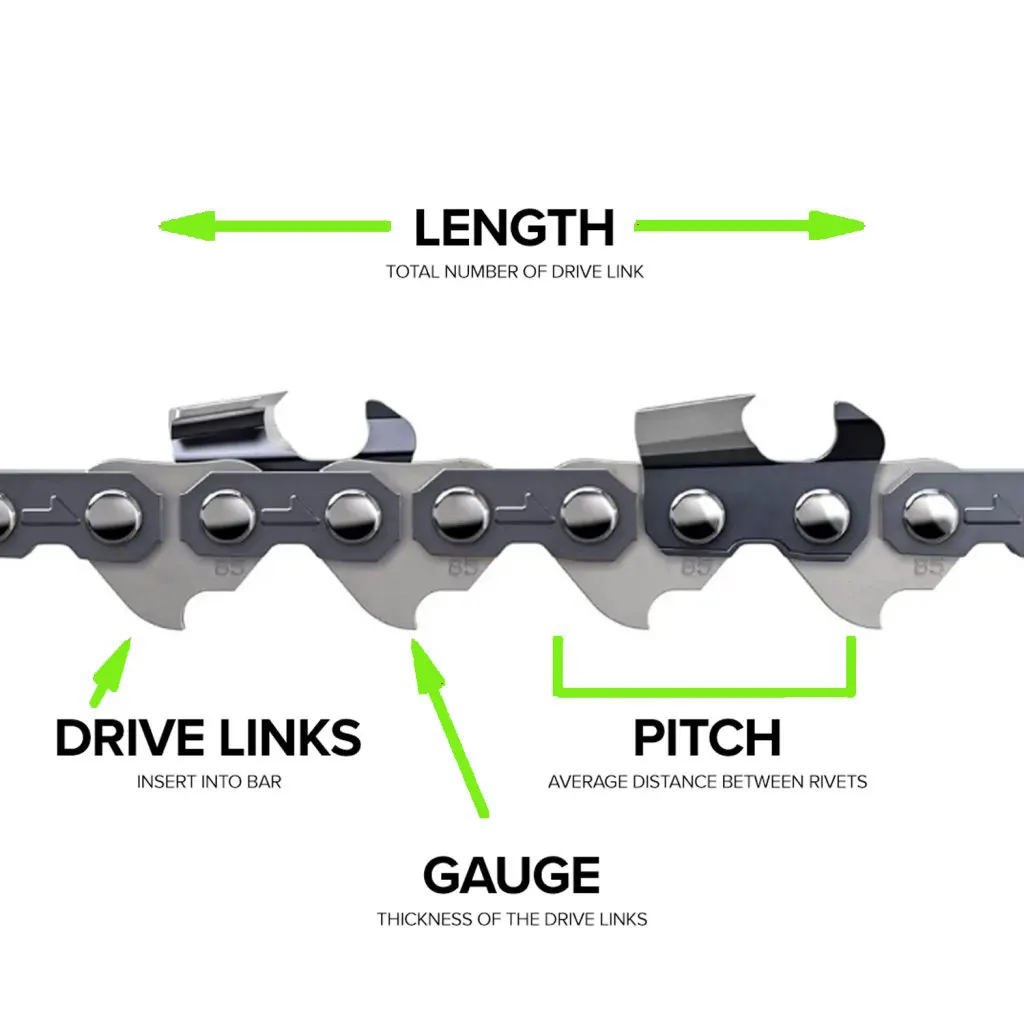What is Chain Pitch and Gauge? Quick Guide
- September 10, 2024
- 0 comment
Accurate knowledge of chain pitch and chain gauge is critical for optimizing your chainsaw’s performance and safety. These measurements play a significant role in ensuring smooth cuts and prolonging your equipment’s life. This article will guide you through the importance of chain pitch and gauge, explain how they impact chainsaw efficiency, and help you select the right chain for your specific needs.

What is Chain Pitch?
Chain pitch refers to the distance between any three consecutive rivets on the chain, divided by two. This measurement is crucial because it determines how well the chain fits into the saw’s sprocket. The right chain pitch ensures smooth operation and proper tensioning.

How to Measure Chain Pitch
To measure the pitch of your chainsaw chain:
- Identify any three rivets on the chain.
- Measure the distance between the first and the third rivet.
- Divide this measurement by two.
For example, if the distance between the first and third rivet is 0.75 inches, the pitch would be 0.375 inches, commonly rounded to 3/8”.
Common Chain Pitch Sizes
Most chainsaws come with standard pitch sizes. The most common are:
- 1/4 inch: Used for smaller chainsaws and light trimming work.
- .325 inch: A mid-range size used on medium-duty chainsaws.
- 3/8 inch: Ideal for larger chainsaws and heavy-duty work.
- .404 inch: Designed for professional-grade chainsaws used in forestry.
What is Chain Gauge?
Chain gauge refers to the thickness of the drive links, the small metal projections that fit into the chainsaw’s guide bar. Choosing the correct gauge is essential for maintaining a proper fit between the chain and guide bar.

How to Measure Chain Gauge
Measuring the chain gauge is straightforward:
- Use a caliper to measure the thickness of a drive link.
- Ensure the measurement matches your chainsaw’s guide bar specifications.
Most chainsaws list the compatible gauge size in the owner’s manual or on the chainsaw’s guide bar.
Common Chain Gauge Sizes
The most frequently used chain gauge sizes include:
- .043 inch: For lightweight saws and narrow-kerf bars.
- .050 inch: The most common gauge for general use.
- .058 inch: A thicker gauge used for heavy-duty work.
- .063 inch: Found on large, professional chainsaws, particularly in forestry work.
Why Are Chain Pitch & Gauge Important?
Using the wrong chain pitch or gauge can lead to poor chainsaw performance, increased wear on components, and even dangerous situations such as kickback or chain breakage. Here’s why these measurements matter:
- Compatibility with Your Chainsaw
- Chainsaw bars, sprockets, and chains must be compatible. The wrong chain pitch or gauge will cause improper tension, leading to issues like chain slippage, excessive wear on parts, or uneven cutting.
- Performance and Efficiency
- The right chain pitch and gauge ensure your chainsaw runs smoothly, cuts effectively, and uses fuel efficiently. For instance, a chainsaw with a higher-pitch chain will cut larger chunks of wood faster, while a lower-pitch chain is better for finer cutting.
- Safety
- Using a chain that doesn’t match your saw’s specifications increases the risk of kickback, where the saw is thrown back toward the operator. Proper chain tension, which depends on the correct pitch and gauge, is crucial for reducing kickback and other potential hazards.
How to Choose the Right Chain Pitch and Gauge for Your Chainsaw
Choosing the right chain pitch and gauge depends on several factors, including the type of work you plan to do, the size of your chainsaw, and the manufacturer’s recommendations. Here’s a step-by-step guide to help you make the best choice:
- Check Your Chainsaw’s Guide Bar
- The easiest way to ensure you select the correct chain is to check the information engraved on your chainsaw’s guide bar. This will list the compatible chain pitch, gauge, and length.
- Determine the Type of Cutting Work
- For light pruning or trimming, a smaller pitch (such as .325 inch) and gauge (like .043 or .050 inch) will suffice. For felling large trees or heavy-duty cutting, you’ll want a larger pitch (3/8 inch or .404 inch) and thicker gauge (.058 or .063 inch).
- Sprocket Compatibility
- If you are replacing your chainsaw chain, it’s essential to ensure that the pitch matches your chainsaw’s sprocket. Changing the sprocket is not as common as replacing the chain, but if needed, you can upgrade both components for optimal performance.
When Should You Replace Your Chainsaw Chain?
Regular maintenance of your chainsaw chain is essential for safety and efficiency. But how do you know when it’s time to replace your chain? Here are some common signs:
- Dull Chain Teeth
- If sharpening your chain no longer results in effective cutting, it’s time to consider a replacement. Over time, the teeth wear down, making the chain inefficient.
- Stretched Chain
- Chains can stretch over time with use, especially if the pitch and gauge are incorrect. If you’re having difficulty adjusting the chain’s tension, even after tightening it properly, the chain may have stretched beyond safe use.
- Worn Drive Links
- If the drive links show signs of excessive wear or damage, such as rounding or thinning, it’s a clear indication that the chain needs replacing. Worn drive links can cause the chain to slip off the guide bar, leading to accidents.
- Cracked or Damaged Chain
- Any visible cracks or breaks in the chain require immediate replacement. Continuing to use a damaged chain can lead to catastrophic failure during operation.
How to Maintain Your Chainsaw Chain
Proper chain maintenance ensures longevity, safety, and optimal performance. Here are some best practices for keeping your chainsaw chain in top condition:
- Regular Sharpening
- Keep your chain sharp by sharpening it after every few hours of use. A dull chain not only slows you down but also increases the risk of accidents.
- Correct Tensioning
- Always ensure the chain is correctly tensioned. A chain that is too loose can come off the guide bar, while one that is too tight can cause excessive wear on the chain and guide bar.
- Lubrication
- Chains require consistent lubrication to prevent friction and heat buildup. Ensure your chainsaw’s oiling system is functioning properly, and use the correct bar and chain oil for your machine.
- Inspection for Damage
- After every use, inspect your chain for any signs of wear, stretching, or damage. Early detection can prevent more significant issues and ensure safety.
Conclusion
Understanding chain pitch and gauge is crucial for anyone using a chainsaw, whether you’re cutting firewood, trimming branches, or working in forestry. These measurements directly impact your chainsaw’s performance, safety, and longevity. Always ensure that your chainsaw chain matches the specifications listed by the manufacturer and maintain the chain regularly for optimal use.
Choosing the right chain pitch and gauge not only improves cutting efficiency but also extends the life of your chainsaw, reducing downtime and maintenance costs. With the right knowledge and maintenance practices, you can keep your chainsaw running smoothly and safely for years to come.
FAQs About Chain Pitch & Gauge
- What is chain pitch on a chainsaw?
Chain pitch is the distance between three consecutive rivets on a chainsaw chain, divided by two. It determines how well the chain fits the saw’s sprocket. - How do I measure chain pitch?
To measure chain pitch, measure the distance between the first and third rivet on the chain, then divide by two. Common pitch sizes are 1/4″, .325″, 3/8″, and .404″. - What is chain gauge?
Chain gauge refers to the thickness of the drive links that fit into the guide bar. Common gauges include .043″, .050″, .058″, and .063″. - Why are chain pitch and gauge important?
Chain pitch and gauge ensure the chain fits properly on the chainsaw, affecting performance, safety, and cutting efficiency. - Can I use any chain pitch on my chainsaw?
No, you must use a chain pitch that matches your chainsaw’s sprocket and guide bar specifications for optimal performance and safety. - What happens if the chain gauge is too thick for the guide bar?
If the chain gauge is too thick, the chain won’t fit into the guide bar groove, leading to improper tension, which can cause the chain to slip or damage the bar. - How do I find the correct chain pitch and gauge for my chainsaw?
The correct chain pitch and gauge are often listed on the guide bar or in your chainsaw’s manual. Always match the chain to the manufacturer’s specifications. - What is the difference between .325 and 3/8 pitch chains?
.325 pitch chains are lighter and suitable for smaller chainsaws, while 3/8 pitch chains are larger and ideal for heavier cutting tasks and professional use. - Can I mix different chain pitches on the same chainsaw?
No, you must use a chain with the same pitch as the sprocket and guide bar. Mixing pitches can lead to improper chain tension and increased wear. - When should I replace my chainsaw chain?
Replace the chain when it becomes dull, stretched, or if the drive links are worn. Regular maintenance can extend the chain’s lifespan, but damage requires immediate replacement.

Charles Hayes
Forestry AuthorI'm Charles Hayes, I bring over 15 years of specialized expertise in landscaping and woodworking, blending artistic design with sustainable environmental stewardship. My career, fueled by a profound passion for the natural world, encompasses extensive education and hands-on experience in creating harmonious, eco-friendly outdoor spaces and responsibly managing forest resources. Recognized for my professional standing, I am committed to continuous learning and certification in cutting-edge practices. My expertise is not only reflected in my work but also in my contributions to community projects, educational workshops, and collaborations with industry leaders. As an authoritative voice in my field, I strive to share knowledge and promote environmentally conscious approaches, making me a trusted resource in landscaping and forestry.













Leave your comment